- Home
-
Overview
- Study Guide
- The Single Most Important Idea
- Mission Statement
- War Is Not Inevitable keynote speech
- Capstone Essay: "To Abolish War"
- An Action Plan
- The Nine Cornerstones
- How Far We Have Already Come
- The Secret Ingredient
- The Vision Thing
- How Long It Will Take
- What You Can Do
- The AFWW Logo Explained
- Examples of War Expenses
- Biological Differences
- What Makes People Happy
- Map of Non-warring Cultures
- Cornerstones
- Videos
- Books
- Blog
- Project Enduring Peace
- About
- Related Projects
- Contact
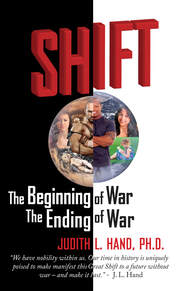 By Judith Hand. There are myriad reasons—psychological, proximate, and ultimate (biological)—for why we make war. We’ve indulged in this deeply embedded, very bad cultural habit for a very long time, so skeptics are on solid ground to believe that ending it may not be, most likely isn’t, possible. But in Shift: The Beginning of War, The Ending of War I explore how we CAN end war, if we choose to. No biological barrier prevents us from breaking this habit; as with all bad habits, including one as deeply engrained as war, breaking free is a matter of will. Once we resolve to act, two kinds of efforts will be required for success, admittedly more simply said than done. We must:
 We’d be engaged in a titanic struggle with an ancient monster having many tentacles: in our history, our mythologies, our economics, and our daily lives. To prevail we need a blueprint for how to subdue the beast. How can we consistently resolve serious disputes between nations or between ethnic groups and so on without killing each other? How do we move hearts and minds into a future culture where the idea of slaughtering people in another group for any reason has become absolutely unthinkable? As it turns out, we don’t have to invent that blueprint from scratch. There are known basics that can guide our planning. Throughout history some people—led by visionary individuals in close touch with their innate moral compass, and arguably, also in touch with good sense—some people have found ways to achieve the goal of peace. People who created “peace systems.” What do such systems look like? In an 18 May issue of a 2012 paper in the prestigious journal Science, anthropologist Douglas Fry wrote an article with the title “Life Without War.” He defines “peace systems” as neighboring societies that do not make war on each other, and points out that they exist on several continents. First he lists peace systems found in Australia, Canada, India, Malaysia, Greenland, and The United States, the latter itself an example of a peace system; people living in the 50 states of this confederation do not make war to resolve their serious disputes: they take them to courts of law and ultimately to the Supreme Court. 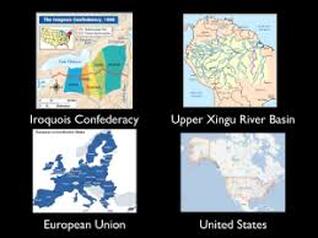 Then he compared three very different systems, looking for shared characteristics: the Iroquois Confederacy of Upper New York State, the Upper Xingu River basin tribes of Brazil, and the European Union. From this comparison he hypothesizes that six features are critical to the creation and maintenance of any peace system:
These societies are not Utopias, not close to it. They may even make war with outsiders to their union. But they found ways to avoid warring among themselves. Our quest would be to build a global peace system, guided by these critical necessary conditions. 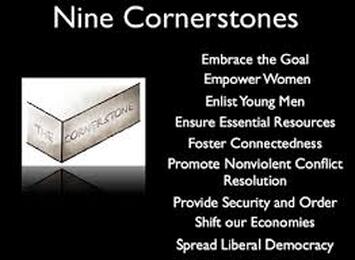 In Appendix III of Shift, I compared nine cornerstones of the project A Future Without War.org (AFWW) I identify as being key to ending war and maintaining peace with the six factors Fry hypothesized as being critical. The objective of making this kind of comparison is to indicate commonalities derived independently by different investigators. The process spotlights the most obvious key elements of success. Appendix II of Shift added to this search for commonalities by presenting a similar comparison with the recent book by Harvard psychologist Stephen Pinker, The Better Angels of our Nature: Why Violence is Declining. What follows is from Shift’s Appendix III, the comparison with Fry’s Science paper. 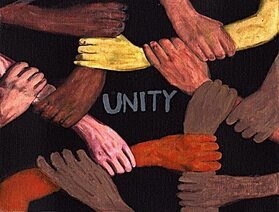 Five of Fry’s six characteristics of peace systems overlap with or are embraced by one or more AFWW cornerstones. For example, in his discussion of “overarching social identity” he takes on the question of “us-versus-them” mentality that can foster conflicts and willingness to use violence against the “other.” He describes methods used by his three peace systems to “expand the us” to encompass a sense of common identity. The methods, not surprisingly given the great diversity of societies involved, are unique to each setting. Logically, a campaign to end war will have to devise methods suitable for creating a global sense of social identity. This corresponds to the work done and institutions embraced by the AFWW cornerstone “Foster Connectedness." Links to just a tiny few of already existing groups working on this issue are listed on an AFWW Related Projects “Foster Connectedness” web page. The spirit this encompasses is perhaps most familiarly expressed in the Coke jingle: “I’d like to teach, the world to sing, in perfect harmony.” That same spirit was part of the intention of the reestablishment of the Olympics in 1896, which have become, sadly, politicized but could be refurbished to truly unite the global community in the shared celebration of human achievement. There are many creative ways, already known and to be invented, to foster a global sense of oneness. 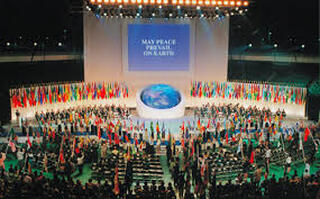 Addressing “intergroup ties,” he points out that intergroup bonds of friendship and kinship discourage violence. He describes how peace systems use ceremonial unions, fictive and genuine inter-marriage that establishes a sense of kinship, economic partnerships, and personal friendships to create such ties. The World Peace Prayer and Flag Ceremony, first begun in Japan and pictured here in Los Angeles, is an example of how shared ceremonies could bind the world in a permanent peace commitment. These practices are, again, ones being advanced by AFWW's "Foster Connectedness" organizations and projects. The AFWW website provides links to a few of them. 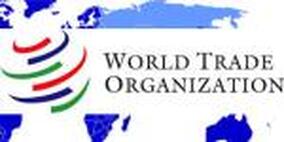 “Interdependence” in Fry’s paper refers primarily to economic interdependence and its power to promote cooperation. People who trade with each other, especially if they depend on this trade, are less likely to make war with each other. Is the WTO, for example, perfect? No. No human organization is perfect. It can, of course, be improved upon. But it provides a forum for resolving serious resource disputes without killing each other. Many regional trade organizations serve a similar function. For us to have global peace, success will require that a balance be struck between local sustainability and developing and maintaining crucial trading interdependence between people and nations at the regional and global level. 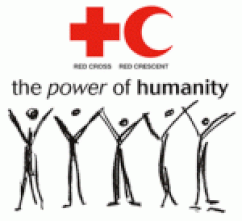 The idea of Interdependence, moreover, includes engaging in cooperation for any kinds of beneficial reasons. For example, in the dry desert of Australia’s west, local hunter-gatherer groups reciprocally allow other groups access to water and food on their "territory" in lean times, because a time will come when they may be the needy ones. Although the International Red Cross and International Red Crescent still reflect the separateness religion has often brought upon us, groups like them work to alleviate suffering and respond to disasters irrespective of natural borders. Something quite fascinating is that some peace systems tend to specialize in production of particular trade goods that they exchange in order to create interdependence. Sometimes they even specifically refrain from producing their own version of “luxury” items that they could make for the specific reason that they understand that trading with the other group, that makes that item which they desire but do not themselves make, is essential to keeping the peace. Organizations like some listed under the AFWW cornerstone “Shift Our Economies” are stressing the importance and potential power of creating many kinds of strategic interdependence.  Fry begins his discussion of “nonwarring values” by pointing out the obvious fact that some value orientations are more conducive to peace than others, and that peace systems live by “nonwarring values.” In the Upper Xingu tribes, for example, the warrior role is shunned: peace is considered moral, war is not. Fry describes the means by which peace-promoting values were enshrined by the Iroquois Confederation. In the case of the European Union, he describes how actualization of the values of democracy, social equality, human rights and the rule of law serve as the EU’s moral (value) compass. Many of the organizations focused on the AFWW cornerstone “Spread Liberal Democracy” also place emphasis on the pacifying effect for large, modern societies of these facets of liberal democracies. And organizations of the AFWW cornerstone “Promote Nonviolent Conflict Resolution” teach the values and skills of living in peace. So again we have commonality between Fry’s assessment of what it will take to move us beyond war and two more AFWW cornerstones. Fry illustrates a need for “symbolism and ceremonies that reinforce peace” citing participation of all the Upper Xingu tribes in ceremonies to mourn the deaths of deceased chiefs and inaugurate new ones. The funerals to honor deceased members of a royal family is often attended by dignitaries from other countries. Joint ceremonies help unify the Xingu tribes, again fostering connectedness and creating a sense of common identity. For the global human community today, we should also promote a sense of shared destiny.  Tree of Life Tree of Life The Iroquois League was symbolized by a powerful symbol of unity and peace, the Tree of Life. The tree’s white roots represented the desire for peace to spread beyond the confederacy. Clearly the Iroquois understood that peace requires work to maintain it; an eagle perched on top of the tree reminded the tribes to remain vigilant to the threats to peace. As describe in Shift, a campaign, built around the shared goal of creating safe, secure, and healthy places for all children, would likewise need to create an appropriate, unifying symbol to represent the intention to build and maintain such a peace for the children of all generations to follow us. The campaign should also invent ceremonies to celebrate its creation. 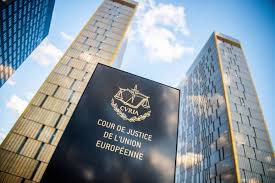 European Court of Justice European Court of Justice If a life without war is to be won and maintained, there must be “superordinate institutions for conflict management.” Fry points out that there are many different ways to manage conflicts between groups, and that one key is to create higher levels of governance. He describes the Council of Chiefs of the Iroquois Confederacy. He describes higher levels of governance created by the EU, such as the European Court of Justice, its exterior pictured here. The commonality is that many of the organizations working on the AFWW cornerstones “Provide Security and Order” and organizations working to “Promote Nonviolent Conflict Resolution” are also concerned with these issues. The United Nations and International Court of Justice are steps we have already taken in the right direction. Fry concludes that creating a planetary peace system would involve many synergistic elements “including the transformative vision that a new peace-based global system is in fact possible….” Here the commonality is with the AFWW cornerstone “Embrace the Goal.” Although at this time only a relatively few organizations are focused on ending all war, the time is ripe for many more to emerge. Two AFWW cornerstones that Fry’s analysis does not directly, or even very indirectly, touch upon are "Empower Women" and "Enlist Young Men." 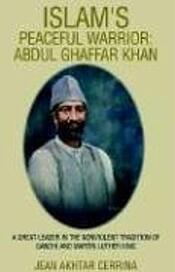 Abdul Ghaffar Khan - Islam's Peaceful Warrior Abdul Ghaffar Khan - Islam's Peaceful Warrior First, the challenge of making restless young males part of the solution—making them supporters of building this peace system—is arguably the least appreciated element of creating a future without war. It’s hard to find organizations dedicated to that cause. The importance of recruiting young men into an effort to end war is seldom mentioned, I believe, since the general assumption is that we will never end war so thinking about the specific problem of how to include young men as part of the process of ending war and/or what to do with them when war is absent has no relevance. The concept of peaceful warriors, like the thousands of men recruited by Abdul Ghaffar Khan, the Muslim Gandhi, is something to be considered as a campaign to end war contemplates how to engage young men in positive ways. Fry also doesn’t acknowledge the importance of empowering women, although women were powerful in the Iroquois Federation and women certainly have influence and the vote within the European Union. Biological facets of our problem are not generally stressed by most scholars, the emphasis being placed on culture rather than biology. Furthermore, it is virtually universally recognized that war is a male behavior, and so how women figure in is not thought to require consideration. 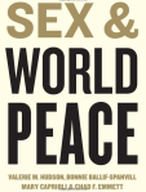 This biologically-based issue is, however, now coming into the discussion. Many organizations are focused on empowering women in a variety of ways. The recent book Sex and World Peace, edited by Valerie Hudson, documents compellingly a strong relationship between the empowerment of women and reduced levels of wars and violence. But is the relationship merely a correlation, or is it causative? Many scholars are cautious, like Yale University professor Nicholas Sambanis. Mara Hvistendahl quotes him in her 2012 Science article “Gender and Violence” as thinking that perhaps what has been called a “woman effect” on peace and stability is perhaps “a proxy for other, more fundamental things, like cultural differences, rule of law, [and] institutional development.” In other words, Sambanis is expressing the view that perhaps the fact that empowerment of women in a society is strongly related positively to its level of peace is simply a correlation. One goal of Shift is to make explicit the importance of very different biological traits of men and women (in general) as these relate to war, and to stress that women’s influence on peace is, in fact, a critical, causative factor. Parity governing -- men and women together as equals in deciding how we choose to live -- needs to be understood as a necessary condition to ending war and even more critically perhaps, to ensuring that peace once achieved endures. Summing up, if we decide to pursue a warless future with sufficient will, we have actual examples and models to learn from. They encourage us to know that we can succeed. The following are the commonalities between AFWW cornerstones and common elements that Fry discovered:
The challenge now for the global community is to put these essentials in place on a global basis ASAP, and never let them slip into disuse.
If you’d like to be inspired and encouraged, treat yourself to a video documentary entitled “The Evolution of a Global Peace System.” Based on historian Kent Shifferd's book From War to Peace, it should be widely publicized and appreciated. This 24 minute video is inspiring, not because of razzle-dazzle, but because it compellingly documents over 20 remarkable, hopeful trends of the last 100 years, many of them key elements of any peace system. They reflect evolution toward a planetary loyalty and sense of human oneness that will be critical to seizing a prize for humanity that no generation before us ever came close to.
1 Comment
Leave a Reply. |
Follow Me on Facebook
If you'd like to read my take on current affairs, or get a sense of what amuses me or I find educational or beautiful, do a search and follow me, Judith Hand, on Facebook. About the AuthorDr. Judith L. Hand. Dr. Hand earned her Ph.D. in biology from UCLA. Her studies included animal behavior and primatology. After completing a Smithsonian Post-doctoral Fellowship at the National Zoo in Washington, D.C., she returned to UCLA as a research associate and lecturer. Her undergraduate major was in cultural anthropology. She worked as a technician in neurophysiology laboratories at UCLA and the Max Planck Institute, in Munich, Germany. As a student of animal communication, she is the author of several books and scientific papers on the subject of social conflict resolution.
Categories
All
Archives
November 2019
|
A Future Without War
Believe in it. Envision it. Work for it.
And we will achieve it.
Believe in it. Envision it. Work for it.
And we will achieve it.
AFWW is continually developed and maintained by Writer and Evolutionary Biologist Dr. Judith Hand.
Earth image courtesy of the Image Science & Analysis Laboratory, NASA Johnson Space Center. Photo Number AS17-148-22727 eol.jsc.nasa.gov
©2005-2019 A Future Without War. All rights reserved. Login
Earth image courtesy of the Image Science & Analysis Laboratory, NASA Johnson Space Center. Photo Number AS17-148-22727 eol.jsc.nasa.gov
©2005-2019 A Future Without War. All rights reserved. Login
- Home
-
Overview
- Study Guide
- The Single Most Important Idea
- Mission Statement
- War Is Not Inevitable keynote speech
- Capstone Essay: "To Abolish War"
- An Action Plan
- The Nine Cornerstones
- How Far We Have Already Come
- The Secret Ingredient
- The Vision Thing
- How Long It Will Take
- What You Can Do
- The AFWW Logo Explained
- Examples of War Expenses
- Biological Differences
- What Makes People Happy
- Map of Non-warring Cultures
- Cornerstones
- Videos
- Books
- Blog
- Project Enduring Peace
- About
- Related Projects
- Contact

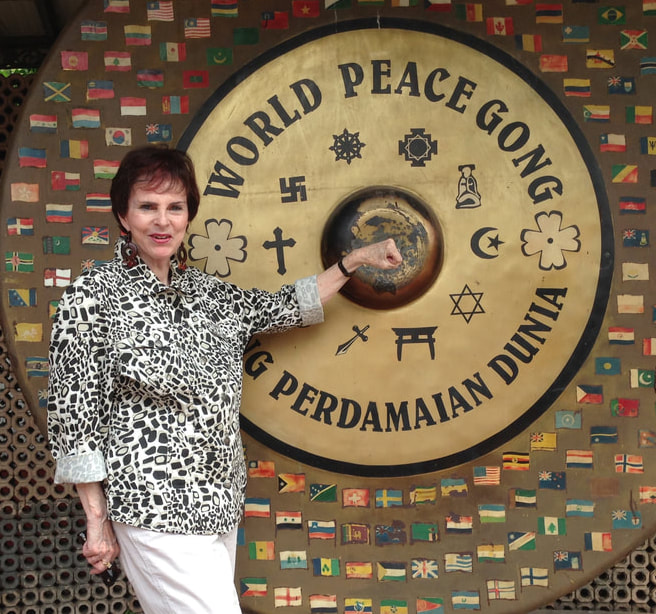
 RSS Feed
RSS Feed